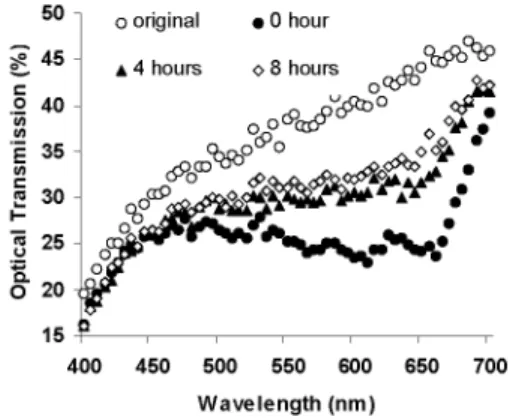High Optical
Efficiency
of
ZnO Nanoparticles
Sumeyra Teka,c and Hilmi VolkanDemira.b.c'DepartmentofPhysics,bDepartmentofElectrical and Electronics Engineering, 7Nanotechnology ResearchCenter,
Bilkent University, Ankara, 06800, Turkey Dilek Yucel andGulsen Celiker
DYO, Yasar Group, A.0.S. B., 10003Sk. No:2,Cigli, Izmir 35620 Turkey volkan@bilkent. edu. tr
Abstract: We develop optically efficient photocatalytic ZnO nanoparticles that we chemically embed and well disperse into host PVAc thin films and experimentally
demonstrate the highest optical efficiency of -70%O in ZnO nanoparticle films, with increasing optical spectral efficiency as the excitation wavelength is swept from 370 nm to 290 nm.
©2007Optical Society of America
OCIScodes:
Nanophotonics, (160.4670) Optical
materials,
(160.4760)
Optical properties
Nanostructured metal-oxide semiconductors find interesting applications in nanophotonics [1-5]. They
exhibit peculiar optoelectronic and photocatalytic properties that make them attractive, for example, for
optical decontamination of surfaces, air, and water. For such environmental purposes, we develop
photocatalytic ZnO nanoparticles integrated in resin andstudy their optical spectral efficiency between 290 nmand 370 nm. We experimentally achieve very high optical efficiencies up to
700o
in ZnOnanoparticle films for the first time.Inphotocatalytic processes, semiconductors such asTiO2, ZnO, CdS, and ZnS are optically activated in ultraviolet(UV)radiation [1, 2].TiO2inthe anatase form is themost common one.However, ZnO(3.2 eV)
is a betteralternative toTiO2 as far as its bandgap energy is concerned, although it is less commonly used. ZnOis the last member of the 3d metal-oxide series, with Zncompletelyfillingits 3d orbitals
(3d'0).
ZnO's conduction band has s-p hybridized orbitals while its valence band has only d-states. This results in the dissimilar parityof the photoexcited e--h+ pair in ZnO, leading to a low recombination probability, as in TiO2. Thus, ZnO and TiO2 are the only two among the 3d transition metal-oxide semiconductor series that remain stable upon photoexcitation [3]. It is also reported in the literature that ZnO powder hassignificantly larger quantum efficiency than that of TiO2 powder [1]. This motivates us to investigate optical efficiencycharacteristics of ZnO.
To this end, many research studies about ZnO in aqueous solutions have been conducted. However, little research is available for ZnO and itsphotocatalytic efficiencies when ZnOnanparticlesare embedded and immobilized in thin films (although immobilized form is comparatively more versatile in industrial
applications). Inthis work, we thus work on the optical efficiency characterization of ZnO nanoparticles
integrated in resin and report on very high spectral efficiencies for such ZnOnanoparticle films for the first time.
50 o original o0hour
S45 4hours o8hours
00
oo5)
40
Q E 359?30<jO
25-C-, o 20 15 400 450 500 550 600 650 700 Wavelength (nm)Fig. 1. Optical transmission spectra of our zinc oxide nanoparticles film right before (original) and after (0 hour) it is contaminated with methylene blue, and subsequently when optically activated for 4 and 8 hours at 290 nm. With optical activation in UV, the initial
We use ZnOparticles of 100 nm in size. We chemically integrate and disperse these ZnO nanoparticles into host PVAc (poly(vinylacetate)/ poly(methylmethacrylate)) resin. We form thin films of the resulting ZnOnanocomposite by spraying. We contaminate our samples with the standard metylene blue for optical characterization. We optically activate at certain wavelengths in the UV (from 370 nmto 290 nm) and perform optical transmission spectroscopy in the visible (between 450nmand 700nm). During the optical activation process, we observe visual changes in the color of our samples. Figure 1 shows typical optical transmission spectra through our ZnO nanoparticle film with no contamination (original) and with the contamination but nooptical activation(0hour). Due to the contamination, there is a significant drop in the
opticaltransmission. However, with theopticalactivation(for4hours and 8 hours with anopticalpowerof 120 ptW at awavelength of 290 nm), the ZnO nanoparticle film recovers its optical transmission back up by
7000 atthe end of 8 hours. This opticalrecoveryis attributedmostlytothephotocatalytic activityof ZnO nanoparticiples. The degradation of the host resin may also in part contribute to the optical recovery of the transmission.
For acomplete study of optical spectral efficiency characterization, we study the changes in the optical transmission of ZnOnanoparticlesinthe visible spectra as wechangethe excitationwavelengthinthe UV. We use a measure ofoptical efficiency to evaluate and compare the photocatalytic activity under UV exposure at different wavelengths. We extract the optical efficiency from the spectral area between the
opticaltransmission curves of the samplebefore and afteropticalactivation normalized with respect to the
spectral areabetween the transmission curves before and after contamination across a widespectral region
(in the visible between 450 nm and 700 nm), over which the effect of the contamination and decontamination is observed. Figure 2 shows the optical efficiencies of our ZnO nanoparticles for excitation wavelengthsbetween 290 nmand 370nmas a function of incident totalopticalenergy perunit
area (between 1.8
Joules/cm2
and 7.6Joules/cm2).
We demonstrate that optical efficiencies increase withdecreasing excitationwavelengths.Weobtainhigh optical efficiencyupto
700o
at290 nmshown inFig.2.-)-@
290 nm O@- 310 nm 80 -0-@ 330 nm * --@ 350nm ,60--*@
370nm 60 50 40 w 3 30 C., ~0 10 0 1.8 3.8 5.8 7.8Energyper unitarea
(oules
cm)
Fig.2.Optical efficiency ofourzinc oxidenanoparticlesatdifferent activationwavelengths between290 nmand370 nm as afunction of incident totaloptical energiesperunitarea.
Inconclusion, wedevelopedand investigated photocatalytic ZnOnanoparticles integrated inthin films for optically induced decontamination and characterized their optical spectral efficiency at excitation
wavelengths from 290 nm to 370 nm. We experimentally demonstrated that optical efficiencies increase with decreasing excitation wavelength. We obtained thehighest optical
efficiency
of7000 at290nm. We are currently workingonthe development of ZnOnanoparticles embedded in other resins to furtherstudyandidentify opticallyinduceddegradationmechanisms.
References
[1]S.Chakrabarti,B. K.Dutta,"Photocatalytic degradation of model textile dyesin waste waterusingZnO assemiconductor catalyst," Journal of Hazardous Materials 112,269-278(2004).
[2]G.Mascolo,R.Comparelli,M.L.Curri,G.Lovecchio,A.Lopez & A.Agostiano, "Photocatalytic degradation of methylred by TiO2: Comparison of the efficiency of immobilized nanoparticlesversusconventionalsuspended catalyst," Journal of Hazardous Materials (2006) (in press).
[3] S. Banerjee, J. Gopal, P. Muraleedharan, A.K. Tyagi & B. Raj, "Physics and chemistry of photocatalytic titanium dioxide: visualization of bactericidal activity using atomic force microscopy," Current Science 90, 1378-1383 (2006).
[4]5.Kundu, S. K. Ghosh, M. Mandal, T. Pal & A. Pal, "Spectrophotometric determination of arsenic via arsine generation and in-situ color bleaching of methylene blue (MB) in micellar medium," Talanta 58, 935-942 (2002).

